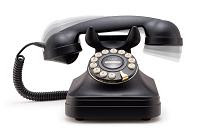The Unwanted Call (On Bluffing)
 Was playing a bit yesterday (my usual pot-limit Omaha game, $50 buy-in) when I was interrupted by a phone call. The land line. Basically no one calls the land line other than telemarketers or perhaps the dentist reminding me of an appointment. I answered, though didn’t interrupt my playing to do so.
Was playing a bit yesterday (my usual pot-limit Omaha game, $50 buy-in) when I was interrupted by a phone call. The land line. Basically no one calls the land line other than telemarketers or perhaps the dentist reminding me of an appointment. I answered, though didn’t interrupt my playing to do so.“Hello?” Nearly ten seconds pass. Then the recording starts, an excited voice saying, with urgency...
“Don’t hang up!”
You can guess what happened next.
For the next few hands I found myself wondering what percentage of those who hear that greeting actually follow its directive and continue to listen. Has to be mighty small, I thought. What a poor strategy.
After a little while I realized that at one of the two tables I had going I had fallen into an interesting bit of cagey back-and-forthing with another player. We’d bet each other out of a few hands, and by the way he was playing I could tell he probably wasn’t always waiting for a hand to place his bets. I knew I wasn’t. I’d bluffed him out of a couple of medium-sized pots, and, like I say, I’m sure he probably had succeeded in doing the same to me.
There are some who never play PLO or who perhaps are novice players who do not realize how big of a role bluffing plays in the game. Believing that someone always must have the nuts, some feel bluffing is rarely (or never) a viable option.
But that is wrong, of course. There are many, many situations in PLO that call for bluffing, and indeed, if one doesn’t realize that, one is either going to lose consistently or (perhaps, if one is patient enough, and sufficiently lucky) win at very, very slow clip. As David Spanier writes in the opening line of his 1977 book Total Poker, “Bluff is the essence of poker.” (More on Spanier’s book here.)
The art of bluffing is complex, to be sure, and aside from determining when the circumstances are correct for bluffing, sizing one’s bets successfully is of crucial importance. In pot-limit games, you have a predetermined range of possible bets from which to choose, from the minimum (one big blind) to the maximum (the size of the pot). The fact is, bluffs come in all possible sizes. Whatever is the right amount to achieve your goal -- i.e., to get the other player to fold the better hand -- is obviously determined by a host of factors.
That little interruption got me thinking how in certain situations, bluffs tend to operate a lot like that phone call. A limped pot. Flop comes


 , an early position player bets pot, and the button just calls. The turn is the
, an early position player bets pot, and the button just calls. The turn is the  . The early position player again bets pot, and the button again calls. The river is the
. The early position player again bets pot, and the button again calls. The river is the  . The early position player checks, and the button bets just under half the pot.
. The early position player checks, and the button bets just under half the pot. Because of several factors, including the pair’s history playing together, the early position player folds his flopped middle set. The button scoops the pot with



 -- nothing but a busted straight draw. The early position player saw that “value bet” on the river and heard “Don’t hang up!” Then he did what most do when hearing that. He hung up.
-- nothing but a busted straight draw. The early position player saw that “value bet” on the river and heard “Don’t hang up!” Then he did what most do when hearing that. He hung up.Of course, at these modest limits, many tend not to hang up with their flopped set in that situation. So you recalibrate the message, trying to size the bet in such a way so as to encourage the response you desire. Probably best to keep the bluffs on the small side and the bets with real hands bigger, if you can manage it. But like I say, bluffs necessarily come in all sizes, shaped according to the circumstances.
Indeed, bluffing helps remind us, as Spanier says in his elaboration on the subject, “there is really no such thing as a good hand in poker, only good situations.”
Maybe some telemarketer will figure out a different way to keep the suckers on the line, perhaps by calling out “Hang up the phone immediately!” Like a wild, incongruous pot-sized river shove, that.
Who could resist the call?
Labels: *shots in the dark, bluffing, David Spanier, pot-limit Omaha, Total Poker














0 Comments:
Post a Comment
<< Home